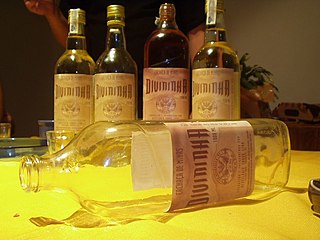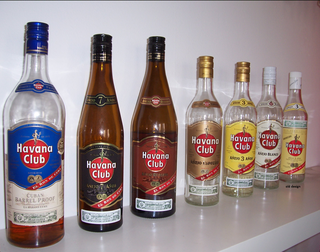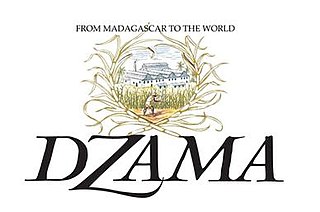
Canadian whisky is a type of whisky produced in Canada. Most Canadian whiskies are blended multi-grain liquors containing a large percentage of corn spirits, and are typically lighter and smoother than other whisky styles. When Canadian distillers began adding small amounts of highly-flavourful rye grain to their mashes, people began demanding this new rye-flavoured whisky, referring to it simply as "rye". Today, as for the past two centuries, the terms "rye whisky" and "Canadian whisky" are used interchangeably in Canada and refer to exactly the same product, which generally is made with only a small amount of rye grain.

Solera is a process for aging liquids such as wine, beer, vinegar, and brandy, by fractional blending in such a way that the finished product is a mixture of ages, with the average age gradually increasing as the process continues over many years. The purpose of this labor-intensive process is the maintenance of a reliable style and quality of the beverage over time. Solera means "on the ground" in Spanish, and it refers to the lower level of the set of barrels or other containers used in the process; the liquid is traditionally transferred from barrel to barrel, top to bottom, the oldest mixtures being in the barrel right "on the ground". The containers in today's process are not necessarily stacked physically in this way but merely carefully labeled. Products which are often solera aged include Sherry, Madeira, Lillet, Marsala, Mavrodafni, Muscat, and Muscadelle wines; Balsamic, Commandaria, some Vins doux naturels, and Sherry vinegars; Brandy de Jerez; beer; rums; and whiskies. Since the origin of this process is the Iberian peninsula, most of the traditional terminology is in Spanish and Portuguese.

Cachaça is a distilled spirit made from fermented sugarcane juice. Also known as pinga, caninha, and other names, it is the most popular spirit among distilled alcoholic beverages in Brazil. Outside Brazil, cachaça is used almost exclusively as an ingredient in tropical drinks, with the caipirinha being the most famous cocktail. In Brazil, caipirinha is often paired with the dish feijoada.

Grant's is a blended Scotch whisky, produced by the company William Grant & Sons in Scotland.

The House of Angostura, also known as Angostura Limited, is a Trinidad and Tobago company famous for the production of Angostura bitters, invented by the company's founder. The company is also a distiller and is the major producer of rum in Trinidad and Tobago. The company also has been used as a vehicle for international expansion by its parent company, CL Financial. As a result of these acquisitions, the company owns distillers in the United States, Canada, The Bahamas and Suriname.

Arrack is a distilled alcoholic drink typically produced in Sri Lanka and Southeast Asia, made from the fermented sap of coconut flowers or sugarcane, and also with grain or fruit depending upon the country of origin. It is sometimes spelled arak, or simply referred to as 'rack or 'rak. It is not to be confused with the anise-flavored distilled spirit called arak or araq. In many parts of India arrack is colloquially known as "desi daru".

Flor de Caña is a brand of premium rum manufactured and distributed by Compañía Licorera de Nicaragua which is headquartered in Managua, Nicaragua and dates back as far as 1890.

Havana Club is a brand of rum created in Cuba in 1934. Originally produced in Cárdenas, Cuba, by family-owned José Arechabala S.A., the brand was nationalized after the Cuban Revolution of 1959. In 1993, French-owned Pernod Ricard and the government of Cuba created a state-run 50:50 joint venture called Corporación Cuba Ron. They began exporting this version of Havana Club globally, except for the United States due to the embargo put in place by the U.S. government.

Dewar's is a brand of blended Scotch whisky manufactured by John Dewar & Sons, Ltd., a unit of Bacardi Ltd.

Rum is a liquor made by fermenting and then distilling sugarcane molasses or sugarcane juice. The distillate, a clear liquid, is often aged in barrels of oak. Rum originated in the Caribbean in the 17th century, but today it is produced in nearly every major sugar-producing region of the world, such as the Philippines, where Tanduay Distillers, the largest producer of rum worldwide, has its headquarters.

Industrias Pampero, C.A. is a Venezuelan rum distiller, and a subsidiary of Gruppo Montenegro. It was founded in 1938 and produces a range of rums, including a white rum Pampero Blanco, an aged rum Pampero Especial, and an aged rum Pampero Aniversario.
Ron Botran is a line of rums from Guatemala distilled by the Industrias Licoreras de Guatemala, the same distillery that produces the Zacapa line of rums. The six Botran rums are Etiqueta Blanca, Añejo Oro, Añejo 8, Añejo 12, Solera 1893, and XL. Ron Botran was first manufactured in Quetzaltenango, Guatemala.

10 Cane was a premium Trinidadian light rum brand owned by LVMH. Moët Hennessy introduced 10 Cane in 2005. The product was discontinued in 2015. 10 Cane rum was named after the tradition of hand-harvesting and bundling sugarcane stalks in groups of ten.
Benjamin Prichard's Tennessee Whiskey is a brand of Tennessee whiskey produced in the small community of Kelso, Tennessee in the United States. Although it is produced by one of only two distilleries operating in Lincoln County – and its unaged variation is named Lincoln County Lightning – Prichard's is not produced using the Lincoln County Process. Due to a special grandfathering exemption under a Tennessee law enacted in 2013, the Prichard's distillery in Kelso is the only producer allowed to label its product as "Tennessee Whiskey" without using this process. Prichard's whiskey is produced entirely using pot stills rather than column stills.
Suntory Global Spirits, formerly known as Beam Suntory, Inc., is the American subsidiary of the Japanese beverage company Suntory. The company produces alcoholic beverages.
Industrias Licoreras de Guatemala is a Guatemalan alcohol distillery which produces different kinds of alcohol and which owns different brands. It was created at the beginning of the 20th century by Venancio, Andrés, Felipe, Jesús and Alejandro Botran, who emigrated from Spain to start a distillery business. It is a private company and it is the biggest of the three distilling companies operating in Guatemala.

Amrut Distilleries Ltd is an Indian company that produces distilled beverages. It is best known for its eponymous Amrut brand of single malt whisky, which is the first single malt whisky to be made in India. The brand became famous after world famous whisky connoisseur Jim Murray gave it a rating of 82 out of 100 in 2005 and 2010. In 2010, Murray named Amrut Fusion single malt whisky as the third best in the world. John Hansell, editor of American magazine Whisky Advocate, wrote that "India's Amrut distillery changed the way many think of Indian whisky - that it was, in the past, just cheap Scotch whisky blended with who knows what and sold as Indian whisky. Amrut is making whisky, and it's very good". In 2019, Amrut Fusion Single Malt Whiskey was awarded the "World Whiskey of the Year Award" and Amrut Distilleries was awarded "Word Whiskey Producer of the Year" at the 2019 Bartender Spirits Awards in San Francisco.

Dzama (/ˈzɑːmə/) "Rhum" is the brand name for rums produced by Groupe Vidzar in Madagascar.
















